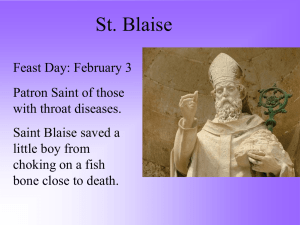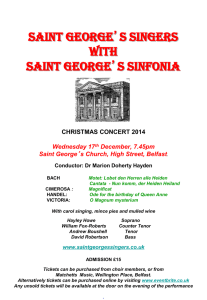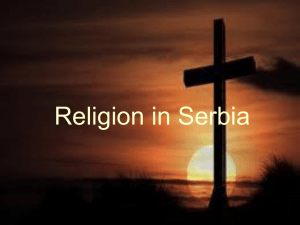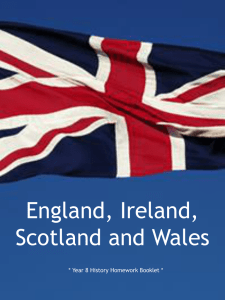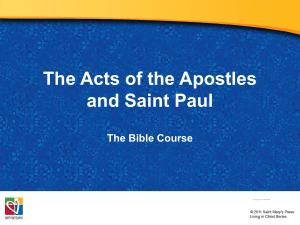Slava
advertisement
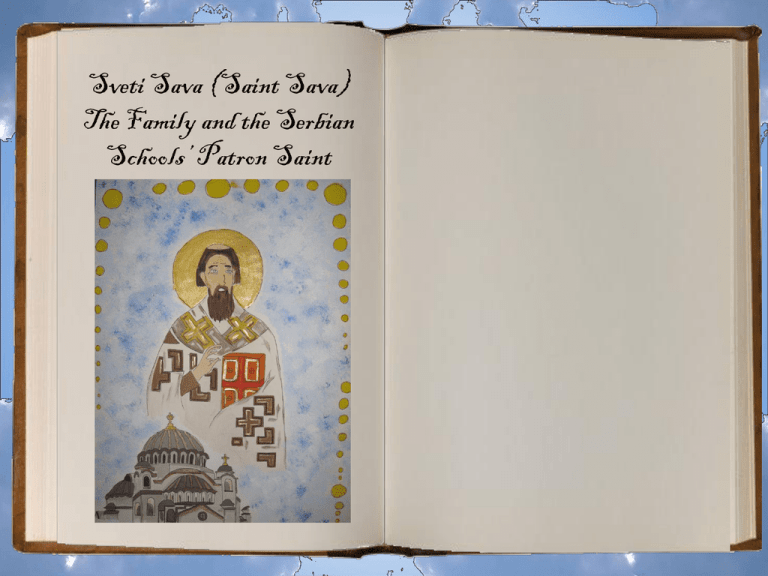
Sveti Sava (Saint Sava) The Family and the Serbian Schools’ Patron Saint Contents Slava (Patron Saint)..............1 Slava in the family...................2 Preslava (little slava)..............3 St. Sava.................................4 The Loaf of Slava....................5 Slava and Jewish Passover Meal............................6 The most celebrated Patron Saints...........................7 Fasting....................................8 Credits (The end)....................9 Slava (Patron Saint) In all the religions worldwide, there is a tradition or a custom of celebrating a day which is for some reason special for an individual or a community. Those reasons, just like the origins of those customs, vary from religion to religion and from culture to culture. In the Western Christianity, for example, there is a tradition of celebrating the Patron Saint, a Saint that is believed to be the protector of a city. Also, there is a tradition of celebrating a day, or better to say, an individual Patron Saint Day, when a child, for example, got its name after the Saint, ‘the name’s day’ as we call it. However, there is among the Orthodox Serbs a variation of the tradition of the Patron Saint, which is actually one of the distinguishing marks of the Serbian Orthodoxy and the Serbian Orthodox Church. The difference lies in the fact that the Patron Saint is not the Protector of an individual only but of the entire family. This, specifically, Serbian family custom, is called Slava (the Celebration, the Glorification). The entire family celebrates it each year on the day of the particular Patron Saint from the moment a family has become Christian,( probably at the moment of the “family baptism”, i. e. the baptism of the entire family). This implies that the Slava or the Patron Saint day is the day of the family gathering or reunion, accentuating the importance of family in the Serbian Orthodoxy, followed by a particular ritual. Slava in the family The host of Slava is the head of the family (pater familias). The role of a host is inherited from the head of the family to sons, just like the way the surname is inherited from father to sons. Since the surname is not only an individual but a family mark, the connection between the surname and Slava is evident and comprehensible only in their family dimension. This connection establishes Slava as the indicator of the genealogical relationships between families and branches of the same family. This is important especially after the Turkish occupation of the Serbian countries, since many Serbs were forced to change their surnames (as it was ordered by the Turks, escaping vendetta s etc.), but they have never changed their Slava. So, if two Serbian families have the same Slava, even without having the same urname, this could be an indicator of possible family ties between them. The sons should celebrate the Slava with their father only if they live under the same roof. If they live separately, they should celebrate it separately, each one in his household. If the head of the family doesn’t have a son, daughters can inherit the Slava only if they stay in the home. As a rule married women by the very marriage start to celebrate their husband’s Slava. Preslava (little slava) Serbs usually celebrate one Slava; yet, some families may celebrate another Saint to a lesser extent for various reasons. If something very important happened to somebody on a certain day (rescue from peril, some extraordinary achievement etc.) than he would adopt the Saint that is celebrated on that day as his another Patron Saint. Or if the wife is the only descendant of her father so otherwise her father’s Slava would be extinguished. All these cases of the Second Slava are named as Preslava or Little Slava. The historical background of Slava is obscure. It is usually said that Slava, as a custom, has roots in pagan worship of Old Slavic household gods as protectors of the families, where pagan Protector of a family was, by mass Christianization of Serbs(ninth century), replaced by a Christian Saint. Although this explanation seems easy and logical, it doesn’t explain why only the Serbs have developed Slava and why many other nations, that have had much more sophisticated and developed religious veneration of household gods (Romans had celebrated Lars as household gods, Greeks had venerated Hestia…), didn’t develop, during their Christianization, some similar custom, but ended up in celebrating the ‘name’s day’. In any case, this simple explanation of the origin of Slava cannot elucidate the specific Serbian character of Slava. codification ofSt. the Sava Byzantine Law, that implements the rich inheritance of the Although SlavaCivil has been present Greco-Roman Law, St. among Sava the Serbsatsince ninth century, already, thethebeginning of theSaint 13th Sava gaveintroduces it the final stamp asState the Century, the Serbian community mark of the Serbian Orthodox and the Serbian Orthodox Church to the Church that heofestablished in 1219, beingand its mainstream the European first Archbishop. civilization. But the importance of Mediterranean Therefore, Saint Sava cannot limited to the St. Sava stands at thebevery beginning of establishment of the Serbian Literature, Orthodox the Serbian Law, the Serbian Church only.Culture The youngest of the the Serbian and thesonSerbian Serbian Great (Duke) Education. No Zupan wonder, then, thatStefan in the Nemanja, Rastko the liberation age of 17 left for 19th Century, afterin the of the the Mount Athos St. whereSava he became a monk. Serbs from Turks, was elected as After StefanSaint Nemanja left the throne for the Patron of Serbian Schools his middle and son, ofStefan Prvovencani (the worldwide the Serbian Education Firstcrowned), and joined at generally. At St. Sava’s his daysonevery Mount Sava,its with the Serbian Athos, School Saint celebrates Patron economic support its of his father, bought a Saint, celebrates School Slava , which is actuallyandreminder all Teachers deserted ruinedformonastery on and the Pupils are one big family They with northernthat brinkthey of Athos-Hilandary. St. as their Head. not only as served a place builtSava a monumental monastery which for life of monks but also as law the At spiritual Hilandary important medieval cultural for Serbs. codes andcentre literary works were transcribed under the supervision of St. Sava. He was also a writer, and we can freely say he stands at the beginning of the independent Serbian medieval literature (D. Bogdanovic). His first literary work, The Karyes Typicon (1199), testifies about the importance of juridical literature for the establishment of the Serbian State and Serbian Church in St. Sava’s worldview. This Typicon, as well as the other two (The Typicon of Hilandary and The Typicon of Studenica) which were written by St. Sava, introduce the main juridical work of St. Sava, Nomokanon. With this especially wine. InoftheSlava rite of Breaking ThetheLoaf the Slava Loaf, the wine is poured over the Loaf so that it makes the sign of the cross The remarkable sign the in the over most the Loaf, symbolizing veryrite of Slava Christ.is The Loaf of Slava (Slavski Kolac). There is the Cross on the top of the Loaf and the abbreviation for “Jesus Christ wins”. The loaf symbolizes the Christ, which can be seen in the rite of breaking the loaf when the priest says to the head of the household “Christ between us”. Partaking of the one loaf, which symbolizes the very Christ, stresses the unity between all members of the family in the Christian faith. The Loaf also contains the Dove (of peace), reminding the members of the family that until the next celebration of Slava peace must rule among them. When the Loaf is placed on the table in front of the Saint’s Icon, a bowl of kolyivo is placed next to it Kolyivo is boiled wheat arranged with various spices, like sugar, grind nuts and cinnemon. In the Gospel Tradition wheat symbolizes the resurrection (The Gospel according to John 12, 24-25). It is dedicated to all the deceased members of the family, to all the ancestors who faithfully celebrated Slava before us, enabling us, today, to celebrate the feast in the same manner, and whose presence is symbolically represented by wheat. Therefore, celebrating Slava unites family not only by gathering it around the Loaf representing Christ, but also temporarily extends, by means of wheat, this celebration to all Christian generations of family. Indispensible elements of Slava are also: a Candle (Slavska Sveca) that is lit on in honor of the Patron Saint, and Slava and Jewish Passover Meal The usage of bread and wine in a religious family feast would point to some important parallels between Serbian Slava and Jewish Passover Meal (see The Book of Exodus 12). Both feasts are strictly family celebrations that gather and spiritually unite family around their central object- Jews are gathered around the Paschal Lamb and Serbs around Christ (symbolized by the Loaf and Wine). If we consider the fact that in the Gospel Tradition Jesus Christ is presented as “our (Christian) Passover Lamb” (The Gospel of John 1,29.36; Paul’s First Epistle to Corinthians 5,7), then the resemblance between the two is even stronger. In both Slava and Jewish Passover Meal, bread and wine are not only simple food but their usage in the meal bears profound theological connotations. Both Jewish Passover Meal and Serbian Slava celebrate the day when families, Jewish and Serbian, became connected to God in a special way as God’s covenant people- Jews in the moment of their Exile from Egypt and Serbian family through their family baptism on the Feast Day of the Family Patron. In any case, the connection between Serbian Slava and Jewish Passover Meal shouldn’t be overlooked. The most celebrated Patron Saints The most celebrated Patron Saints among the Serbs are: Saint Nicholas (19/12 according to the Gregorian Calendar), Saint Michael (21/11), Saint John the Baptist (20/1), Saint George the Great Martyr (6/5), Saint Demetrius (8/11), Saint Stephen (9/1- the Slava of the Nemanjic Dynasty). St. Nicholas St. Michael St. John St. George Fasting If Slava falls in a period of fasting (4 Great Fasts and the most of Wednesdays and Fridays) the Feast consists of fasting meals, based only on vegetables and fish, fat-fee food. Otherwise, it is an ordinary meal with plenty of meat on the table. Still, the most important thing during the celebration is the joyous atmosphere and feeling of unity and love of God, family, relatives and friends visiting, wishing to share the moments of love, peace and love with their loved ones. Credits Darko Krstic Presentation was made by: Ivana Tonsa Milan Stojanovic High school “Bora Stankovic” Nis March 2011.
